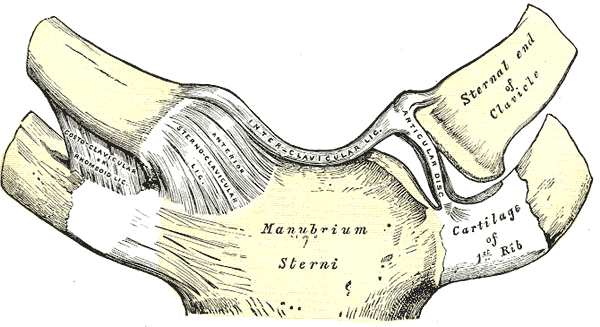Sternoclavicular Joint
{{{{{quality}}}}}

| |
| Sternoclavicular Joint | |
|---|---|
| Primary Type | Saddle joint"Saddle joint" is not in the list (Synovial Joint, Cartilaginous Joint, Fibrous Joint, Compound Joint) of allowed values for the "Has joint type" property., fibrocartilage."Fibrocartilage." is not in the list (Synovial Joint, Cartilaginous Joint, Fibrous Joint, Compound Joint) of allowed values for the "Has joint type" property. |
| Secondary Type | |
| Bones | Manubrium, proximal clavicle"Proximal clavicle" is not in the list (Vertebra, Sacrum, Coccyx, Scapula, Clavicle, Humerus, Radius, Ulna, Scaphoid, Lunate, ...) of allowed values for the "Has joint bones" property., cartilage of first rib"Cartilage of first rib" is not in the list (Vertebra, Sacrum, Coccyx, Scapula, Clavicle, Humerus, Radius, Ulna, Scaphoid, Lunate, ...) of allowed values for the "Has joint bones" property. |
| Ligaments | Sternoclavicular, costoclavicular, interclavicular ligs. |
| Muscles | |
| Innervation | Medial supraclavicular (C3-4) and subclavian (C5-6) nn. |
| Vasculature | Internal thoracic and suprascapular aa. (branches of the subclavian a.) |
| ROM | 35° in the horizontal and coronal planes, 70° range of motion anteroposteriorly, 45° of rotation along its long axis. |
| Volume | |
| Conditions | Sternoclavicular Joint Pain and Instability |
The sternoclavicular joint (SCJ) is a diarthrodial, multi-axial saddle joint, and consists of the articulation between the manubrium sterni, the proximal clavicle, and the cartilage of the first rib. The articular surfaces are covered by fibrocartilage. The joint has an intraarticular disc or meniscus that is made of fibrocartilage. It is attached to the joint capsule anteriorly and posteriorly, first costal cartilage inferiorly and the clavicle superiorly.
The joint is stabilised by the following major ligaments:
| Ligament | Description | Function |
|---|---|---|
| Sternoclavicular ligament | This consists of the anterior, posterior, superior, and inferior sternoclavicular ligaments. It attaches the manubrium sterni to the clavicle | The posterior component, provides primary anteroposterior stabilisation of the SCJ. The anterior ligament also stabilises the SCJ and prohibits excessive superior displacement |
| Costoclavicular ligament | Attaches the cartilage of the first rib to the clavicle | Mediates bilateral clavicle and anterior first rib stability. By anchoring the inferior surface of the sternal end of the clavicle to the first rib, it serves as the primary restraint for the SCJ. |
| Interclavicular ligament | Attaches the proximal end of one clavicle to the other. It also attaches to the superior manubrium sterni. | Facilitates medial traction of both clavicles |
The subclavius muscle also functions to provide joint stability
The SCJ is only of five articulations that allow fluid shoulder girdle movement. It provides 35° range of motion for movement in the horizontal and coronal planes and 70° range of motion anteroposteriorly. It also provides 45° of rotation along its long axis. Movement of the shoulder girdle influences movement of the SCJ.
There are several vital structures directly posterior to the SCJ. This includes the brachiocephalic trunk, internal jugular vein, common carotid artery, innominate artery and vein, vagus nerve, phrenic nerve, trachea, and oesophagus.
In a small portion of cases there is a facet that articulates with the first rib.

